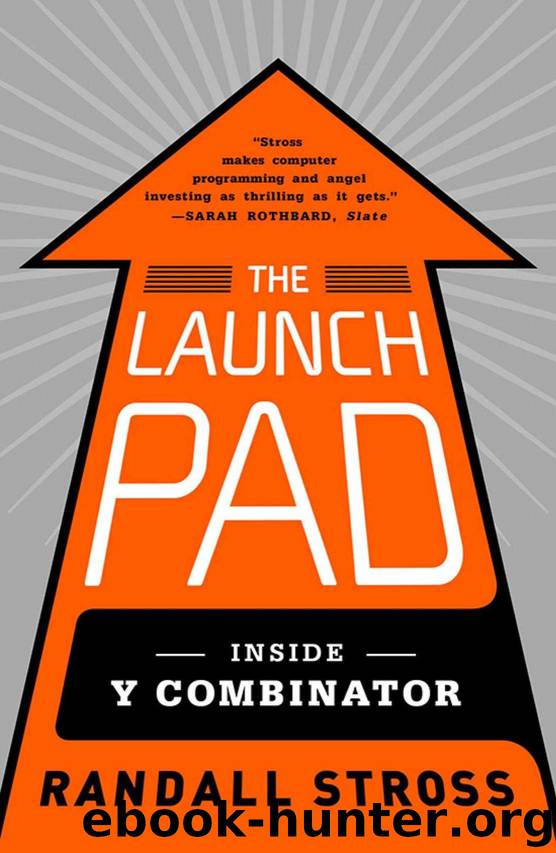The Launch Pad: Inside Y Combinator by Randall Stross

Author:Randall Stross
Language: eng
Format: mobi
Publisher: Penguin Publishing Group
Published: 2012-09-27T07:00:00+00:00
14
RISK
YC partners are interchangeable, Paul Graham told the founders at the beginning of the summer. You can come to any of us for office hours and receive the same advice. In practice, this applied only to the basic YC tenets: work on code and talk with customers; launch fast and iterate; focus on one measurable weekly goal. The founders quickly saw that, beyond the basics, there was plenty of variation. Like an academic department, YC partners were distributed across generations. Graham came of age before Paul Buchheit, who came of age before Harj Taggar, who came of age before Sam Altman. Additional coverage was provided by the other partners: Justin Kan, Emmett Shear, Garry Tan, and, near the end of the summer, the newest partner, Aaron Iba. Founders sense that some partners like their startup’s idea more than do others, and naturally gravitate to them.
Graham is viewed as the best person to go to when thinking about how to expand the idea, and he is also the inspirational figure who can leave founders feeling a surge of energy after office hours with him, eager to get back to their apartment and resume coding. But for help on product design issues, many founders view the advice of the other partners as more reliable. They also know that Graham’s blunt criticism can feel crushing. His colleagues are never immoderate in what they say. When they are critical of the founders’ ideas, they soften the edge of their criticism, claiming that they, the advisers, may well be wrong.
In YC’s first six years, the format for office hours did not change. Founders met with one partner at a time. If they wanted multiple perspectives, they set up office hours with each partner separately. Depending on the partners’ schedules, founders might have to come in on different days.
This summer, however, Graham is trying out two new formats. One is group office hours—two YC partners meet with the founders of six startups, giving the founders the opportunity to see how the partners respond to the questions posed by other founders as well as their own. The other experiment is called, inelegantly, “inflection point meetings,” in which the founders of one startup come in and get the undivided attention of a full panel of YC partners. This cannot be offered to every one of the sixty-three startups; it is reserved for those deemed to be at a critical juncture and in need of the advice of more than one partner. The format suggests that the partners are not fully interchangeable after all and that startups benefit by exposure to many points of view.
It’s a Monday afternoon in early August, and the three founders of Tagstand—Kulveer Taggar, Srini Panguluri, and Omar Seyal—have been invited in for an inflection point meeting. Though Taggar’s surname coincidentally bears a passing resemblance to Tagstand’s name, the startup’s name derives from the tags it sells, each containing an NFC chip. Eventually, NFC technology is expected to enable paying for purchases with a wave of the phone, replacing credit cards.
Download
This site does not store any files on its server. We only index and link to content provided by other sites. Please contact the content providers to delete copyright contents if any and email us, we'll remove relevant links or contents immediately.
Pioneering Portfolio Management by David F. Swensen(6036)
Man-made Catastrophes and Risk Information Concealment by Dmitry Chernov & Didier Sornette(5593)
Zero to One by Peter Thiel(5444)
The Motivation Myth by Jeff Haden(4965)
The Miracle Morning by Hal Elrod(4392)
Elon Musk by Ashlee Vance(3825)
The Art of Persistence: Stop Quitting, Ignore Shiny Objects and Climb Your Way to Success by Michal Stawicki(3557)
Unlabel: Selling You Without Selling Out by Marc Ecko(3450)
Delivering Happiness by Tony Hsieh(3255)
Urban Outlaw by Magnus Walker(3221)
Purple Cow by Seth Godin(3046)
Mastering Bitcoin: Programming the Open Blockchain by Andreas M. Antonopoulos(2868)
The Marketing Plan Handbook: Develop Big-Picture Marketing Plans for Pennies on the Dollar by Robert W. Bly(2762)
The Content Trap by Bharat Anand(2753)
The Power of Broke by Daymond John(2742)
Applied Empathy by Michael Ventura(2723)
The Airbnb Story by Leigh Gallagher(2664)
Keep Going by Austin Kleon(2567)
Radical Candor by Kim Scott(2560)
